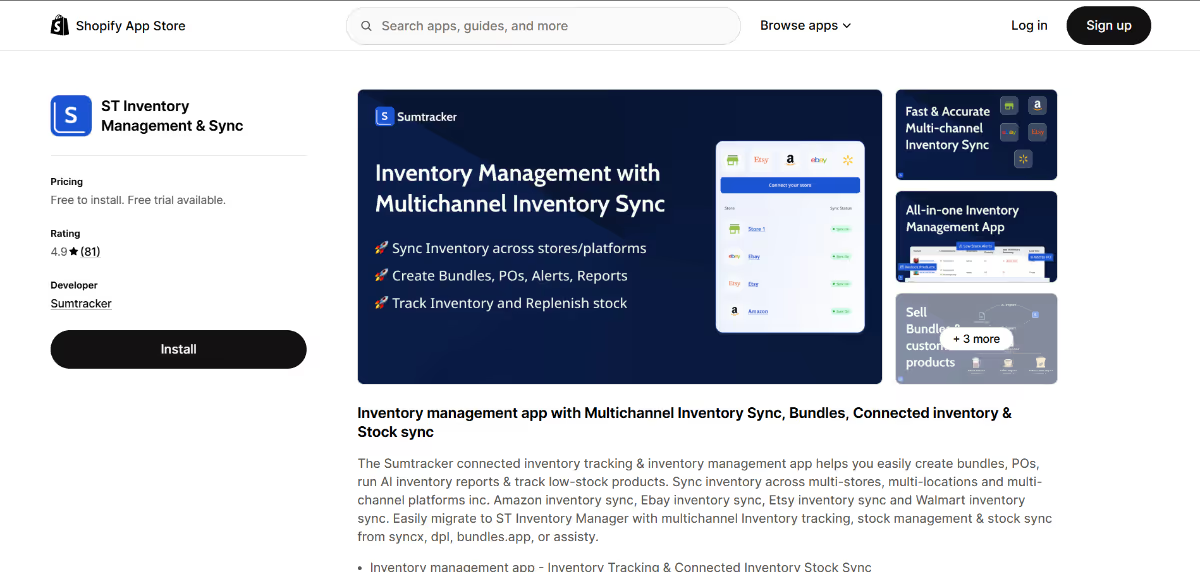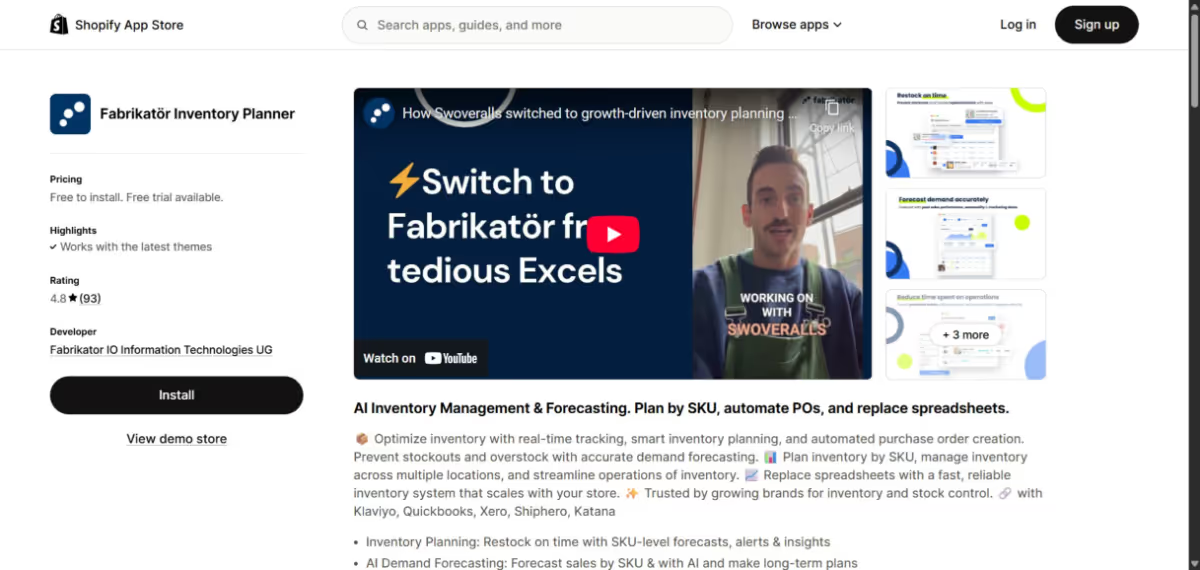If you're trying to streamline your inventory, stay on top of purchase orders, and avoid costly stockouts, you’ve probably come across Sumtracker and Fabrikator.
Both are popular inventory management tools built for Shopify merchants, but they take very different approaches when it comes to features, usability, and growth-readiness.
Whether you're managing simple SKUs or complex bundles, selling on one channel or several, this comparison will help you decide which platform truly fits your eCommerce operations.
Let’s dive into how Sumtracker and Fabrikator stack up and why many growing brands are choosing Sumtracker to scale with confidence.
What Is Sumtracker?
Sumtracker is an all-in-one inventory management platform designed for growing eCommerce brands.
It syncs stock in real time across multiple channels like Shopify, Amazon, Etsy, and eBay, while also offering advanced bundle tracking, purchase order management, and multi-location inventory control.

What Is Fabrikator?
Fabrikator is a Shopify-focused inventory planning and forecasting tool. It helps merchants anticipate stock needs using restock suggestions and historical sales data.
While it offers a clean, easy-to-use interface and supports basic bundling, its features are best suited for single-channel Shopify sellers rather than multichannel operations.

Sumtracker vs Fabrikator: Feature-by-Feature Comparison
Here’s how both tools stack up across the features that matter most to growing eCommerce brands:
Pros and Cons
Choosing the right inventory tool means understanding the trade-offs. While both Sumtracker and Fabrikator bring solid features to the table, they each come with their own strengths and limitations.
Here's a quick side-by-side breakdown to help you evaluate what fits your business best:
Why Shopify Merchants Should Choose Sumtracker
Shopify sellers need more than just stock alerts and reorder suggestions, they need a system that keeps up with how fast they scale.
That’s where Sumtracker comes in.
Built specifically for modern eCommerce brands, Sumtracker offers the flexibility, control, and visibility that Shopify merchants actually need.
Multichannel Inventory Sync That Just Works
Most Shopify-first tools stop at Shopify. Sumtracker doesn’t. It syncs inventory in real time across Shopify, Amazon, Etsy, and eBay, helping you avoid overselling and missed opportunities even as you expand to more channels.
Powerful Bundling with Component Tracking
Selling kits or multipacks? Sumtracker tracks each individual component that makes up your bundles. You get real-time inventory accuracy, even when items are sold as part of different SKUs, something Fabrikator doesn’t support at a granular level.
Mobile-Optimized for On-the-Go Management
Sumtracker is fully optimized for mobile browsers, allowing you to check stock levels, receive POs, or make adjustments directly from your phone without clunky apps or broken layouts.
Restock Planning with Context, Not Just Alerts
Instead of sending generic low stock alerts, Sumtracker gives you customizable restock recommendations based on lead times, sales velocity, and locations. You’ll know what to reorder, when, and how much with logic you can actually trust.
Fast Onboarding and Helpful Support
Getting started is quick. Sumtracker’s onboarding process is straightforward, and their team is known for responsive, human support that doesn’t leave you hanging.
Case Study: From Forecasting Gaps to Full Inventory Control with Sumtracker
- Industry: Home & Lifestyle (DTC eCommerce)
- Sales Channels: Shopify (DTC), Amazon (FBA), Etsy
The Challenge
A fast-growing eCommerce brand initially used Fabrikator to handle inventory forecasting and purchasing. When the business operated solely on Shopify, the tool provided basic functionality for managing stock and generating restock suggestions.
However, as the brand matured and expanded to Amazon and Etsy, new operational demands emerged, and Fabrikator could no longer keep up.
Key Challenges Faced:
- Lack of multichannel inventory sync
- Inventory wasn’t updating across all platforms in real time. Selling a product on Amazon didn’t reflect on Shopify or Etsy, leading to overselling and missed sales opportunities.
- Inadequate bundle and component tracking
- Many products were sold as bundles and kits. Fabrikator couldn’t track components individually, leading to inaccurate available stock levels and fulfillment issues.
- Manual purchase order workflows
- The team had to use spreadsheets and email to manage supplier orders. There was no visibility into what was on order, partially received, or delayed.
- Poor mobile usability
- Warehouse and fulfillment teams needed access to inventory data on mobile devices, but the platform wasn’t optimized for it, slowing down operations.
“We were growing fast, but our backend systems were dragging us down. It felt like we were doing double the work to keep inventory accurate across platforms.”
The Switch to Sumtracker
Realizing the need for a more robust system, the team moved to Sumtracker, a platform purpose-built for growing DTC brands with multi-channel and multi-location inventory needs.
Key Improvements with Sumtracker:
- Real-time sync across Shopify, Amazon, and Etsy
- Advanced bundle and component-level tracking, ensuring product availability is calculated with precision
- Centralized PO system with partial receiving, supplier tracking, and cost breakdowns
- Fully mobile-optimized, allowing staff to check and update inventory straight from their phones
- Custom restock recommendations based on sales velocity, lead times, and buffer stock rules
“The transition was smoother than expected, and Sumtracker covered more ground than just forecasting. It gave us structure across the entire inventory and purchasing process.”
The Results (Within 60 Days)
- Overselling eliminated across all platforms
- PO creation and receiving became 2x faster, with fewer errors
- Warehouse team became mobile-first, improving efficiency and reducing dependency on office computers
- Restocking became proactive, reducing last-minute reorders and stockouts
- Smooth internal transfers between warehouses thanks to multi-location tracking
Conclusion
Both Sumtracker and Fabrikator are built with the same mission in mind, helping eCommerce brands avoid stockouts and make smarter purchasing decisions.
But the difference lies in how far they go.
Fabrikator is ideal for Shopify-only sellers seeking AI-powered restock suggestions and a streamlined interface for managing their inventory. It’s simple, focused, and easy to start with.
Sumtracker, on the other hand, is built for brands that are scaling fast across multiple channels, locations, and complex workflows. With real-time sync, advanced bundle tracking, mobile-first usability, and powerful PO management, Sumtracker offers far more control and operational depth.
If your business is growing beyond the basics and you need a system that grows with you, Sumtracker is the better long-term partner.
FAQS
1. Can I use Fabrikator if I sell on Amazon or Etsy as well as Shopify?
No. Fabrikator is built exclusively for Shopify, so it does not support inventory syncing with Amazon, Etsy, eBay, or other marketplaces. If you sell on multiple channels, Sumtracker is a better fit.
2. Does Sumtracker offer forecasting like Fabrikator?
Yes. Sumtracker provides forecasting based on sales velocity, lead times, and safety stock settings. Sumtracker’s approach offers more control and customization.
3. What happens if the initial data import fails in Fabrikator?
If Fabrikator fails to import your product and sales history from Shopify during setup, its forecasting features may be unusable until the issue is resolved with support. This is why it’s important to test the data sync thoroughly during the trial period.
4. Can both tools manage product bundles?
Yes, but with differences. Sumtracker offers advanced component-level bundle tracking, ensuring that each SKU inside a bundle updates in real time. Fabrikator supports basic bundles but does not track components at the same level of detail.
5. Do either of these tools work on mobile?
Sumtracker is fully optimized for mobile browsers, allowing you to manage inventory from your phone without downloading a separate app. Fabrikator’s mobile experience is limited and best used on desktop.
Conclusion
Ready to Simplify Your Inventory Management?
Join hundreds of e-commerce merchants who rely on Sumtracker to save time, eliminate errors, and grow their business.
.svg)



.png)
.avif)